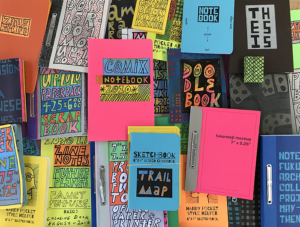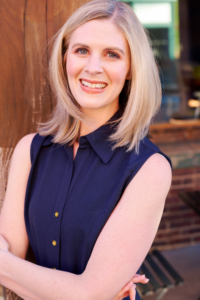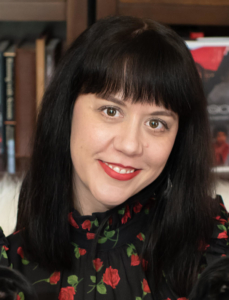Notebooking
 Timothy: As a novice artist, I once spent several months drawing pictures of lizards and turtles for researchers in an animal behavior lab. I loved being around all the gadgets and learning the jargon of science, but the most interesting aspect was watching everyone fill up stacks of green notebooks with scribbled facts, figures, and thumbnail sketches. This largely unseen work of scientific exploration revealed to me a vastly bigger and more complex process than I’d imagined before.
Timothy: As a novice artist, I once spent several months drawing pictures of lizards and turtles for researchers in an animal behavior lab. I loved being around all the gadgets and learning the jargon of science, but the most interesting aspect was watching everyone fill up stacks of green notebooks with scribbled facts, figures, and thumbnail sketches. This largely unseen work of scientific exploration revealed to me a vastly bigger and more complex process than I’d imagined before.
Since then, my education as an artist has taken a pinball’s path, rolling and rocketing from bumper to flipper and back again. Now in the afternoon of this journey, after trying on a dozen different identities, I tell people (and myself) that I make books about books. But, ever skeptical of neat categories and descriptions, I wonder every day what this actually means.
It helps reaffirm my practice to think back to all those amazing lab notebooks overflowing with blue, black, and red ink. Their rich beauty, not meant for the eyes of the lay public, made me interested in the stories behind stories. Of course, I also have the privilege of living with a writer, who has filled so many shapes and sizes of notebooks with ideas. A finished book on the shelf or a painting on the wall can be wonderful things, but to me the messy, freewheeling preparatory work that flows though notebooks and sketchbooks is every bit as fascinating. So, I make, or at least try to make, book-like objects that talk about the often overlooked labor of art.
Bryn: And I have the privilege of living with a visual artist whose sketchbooks burst with wild, beautiful drawings and annotations. Our artistic disciplines intersect in the realm of notebooks: writers, artists, and other creative thinkers, as Timothy mentions, find these compact paper spaces crucial for process and discovery. Time and again, I’ve scratched bits of imagery, scenes, and characters during long walks or early morning coffee; later in the same pages, I’ve refined and expanded those bits or ditched them altogether. I’ve pasted encouraging quotes, pictures, and notes to self. When I drafted Sycamore, I first highlighted and tabbed pages in the stack of notebooks I’d been working in. Some of those scraps made it in wholesale.
Living with an artist, I also know how valuable it is to make a notebook for a project. Book artists in particular build mockups for their projects, mapping and testing structures, and then filling the pages with calculations and notes, before embarking on the final piece. Why shouldn’t writers, too, make their own project-specific notebooks? These serve not only to capture our ideas but to remind us from the start that this work should have its own personalized, playful space that also is practical and portable. Anyone can buy a readymade journal, but slowing down and constructing one from scratch is a kind of promise: This work matters. It’s in my hands now.
ABOUT THE INSTRUCTORS:
About the Instructors: Bryn Chancellor is the author of the novel Sycamore, a Southwest Book of the Year and Amazon Editors’ Best Book of 2017, and the story collection When Are You Coming Home?, winner of the Prairie Schooner Book Prize, with work published in numerous literary journals. Honors include a 2018 North Carolina Arts Council Artist Fellowship and the Poets and Writers Maureen Egen Writers Exchange Award. She is associate professor at the University of North Carolina at Charlotte.
Timothy Winkler is an illustrator and book artist whose Modern Fauna Art & Ephemera Studio is currently based in Charlotte. A native of Nashville, Tennessee, he has long studied and worked in all the various media of printmaking. He earned his MFA in Book Arts at the University of Alabama and has taught letterpress printing at Penland School of Crafts and a course on Outsider Art at the University of North Carolina, Charlotte. Winkler was a 2020 recipient of an Arts and Science Council Artist Support Grant.
CREATE ZINES WITH BRYN & TIMOTHY: The road to a story winds through myriad notes and drafts. Join Bryn & Timothy on April 30, 2022 from 10 a.m. to 3 p.m. for Little Notebooks, Big Ideas: Zines for Creative Exploration. Making notebooks by hand lets writers immerse themselves in the critical early creative process and helps them commit to a project. We’ll make fun, easy, affordable, and portable notebooks in the spirit of zines, closer to Anne Lamott’s index cards than to fussy bound journals. We’ll start to fill the pages with targeted prompts for characters, settings, and scenes, and play with simple printmaking and collage to make them our own. Register Here
Note: This class includes an hour break for lunch. You can bring your own or visit one of several walking-distance options.




